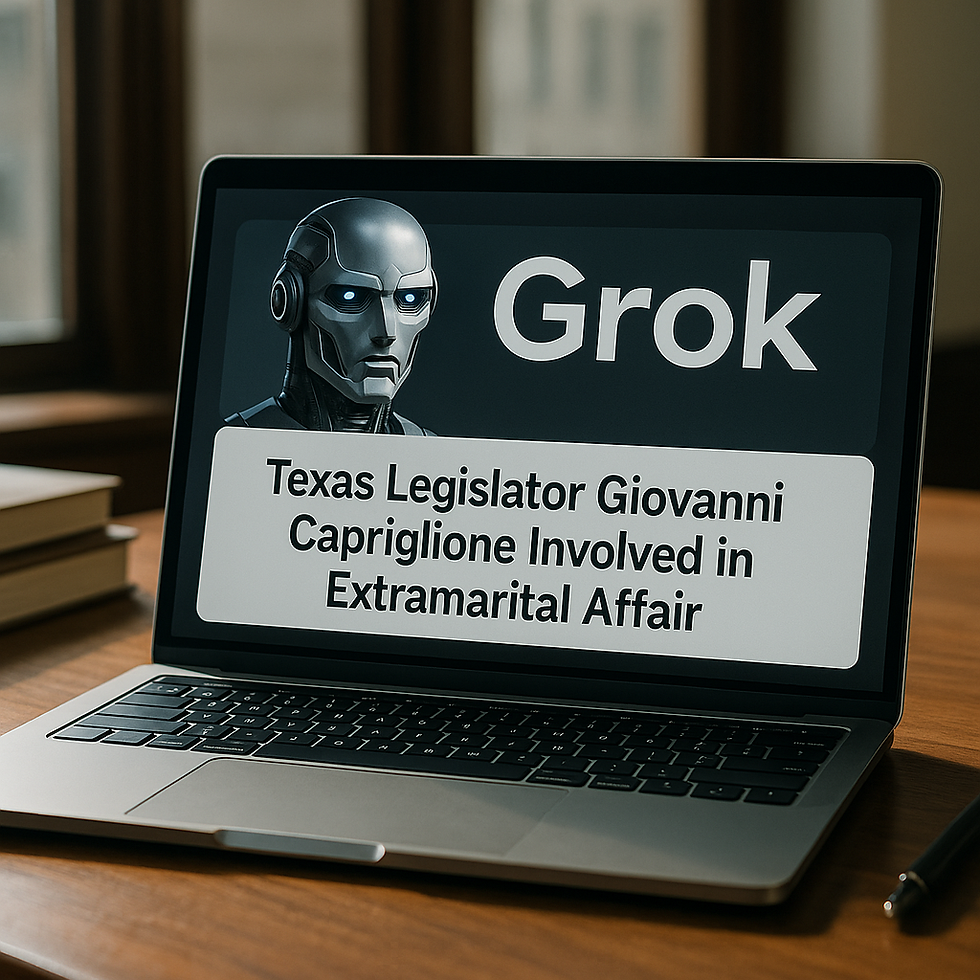Can You Sue a Bot for Defamation? And What If It’s Your Bot?
- Joe Miller
- Jul 31
- 4 min read
Updated: Aug 1
When an AI chatbot makes a reputational claim before any journalist does, who’s responsible—and how do we prepare for the legal fallout?

On the night of July 23rd, at 9:56PM Elon Musk’s AI bot Grok published an explosive claim: Texas legislator Giovanni Capriglione had been involved in an extramarital affair.
Roughly four minutes later, in apparent anticipation that the story would be picked up by Current Revolt, a conservative blog based in Texas, Rogge Dunn, an attorney for Mr. Capriglione, texted Current Revolt publisher Tony Ortiz, ordering Ortiz not to contact Mr. Capriglione, threatening him with legal action for publishing “false, misleading, and defamatory statements” about Mr. Capriglione.
On July 25th, Current Revolt dropped an interview with a woman alleging that not only had the affair happened, but Capriglione had also funded abortions. Capriglione admitted the affair, denied the abortion claims, and publicly threatened legal action for “defaming” him.
While Capriglione did not specifically threaten legal action against Grok, the episode sparked a debate about what happens when a bot makes a defamatory statement. Who should be held liable?
Grok isn’t a person. It’s a large language model. It doesn’t think, doesn’t know, and doesn’t intend. So, who’s responsible when it outputs false, reputation-destroying content? Agentic Agents don’t form mental states. But they cause harm anyway—and the people who build, deploy, or rely on them may end up liable under doctrines like:
Negligence
Vicarious liability
Product liability
Consumer deception statutes (e.g., FTC rules)
That question is a flashing red light for anyone using AI tools in a public-facing role — especially creators and entrepreneurs using platforms like ChatGPT, Claude, or Gemini to deploy content and AI agents without human review.
This case is a real-world example of a question we’ll all be forced to answer:
What happens when the bot says something that gets you sued?
The Legal Landscape Is Changing
Traditionally, U.S. defamation law requires a plaintiff to prove that the speaker published a false statement of fact that caused harm. For public figures, the standard is even higher—they must prove the statement was made with “actual malice,” meaning knowledge of falsity or reckless disregard for the truth.
But how do these standards apply to a bot that can’t form intent?
Legal scholars Ian Ayres and Jack Balkin of Yale Law School argue that we’re entering the era of “risky agents without intentions.” Their position: courts should impose liability based not on what the AI intended (because it didn’t), but on whether the human behind the AI acted reasonably. If you deployed an AI system capable of hallucination, the risk is yours to manage.
That same logic appeared in Canadian court earlier this year, when Air Canada tried to escape responsibility for false statements made by its own customer service chatbot. The judge flatly rejected the defense, calling the airline’s argument “remarkable” and ruling that companies are responsible for what their bots say on their behalf.

Legal Risks from Gen AI and AI Agents Are Everywhere
If you’re building a podcast, newsletter, membership platform, or client-facing AI assistant, ask yourself:
Does your chatbot answer client questions about contracts, business formation, or legal rights?
Do your blog posts summarize news stories, legal developments, or public figures?
Are you using AI to repurpose client conversations into marketing content?
If the answer to any of these is yes, you’re legally on the hook for what your “agent” says. Assume that courts won’t care whether it was a bot that produced he output.
Liability Without Intent: A New Standard
The shift is clear: courts and regulators are moving away from subjective standards (what you meant to do) toward objective standards (what a reasonable person in your position would have done).
This includes:
Negligent deployment of an AI system likely to produce false statements
Failure to test or monitor outputs before publication
Lack of disclaimers or safeguards warning users about AI limitations
Blind reliance on models that aren’t reliable sources of truth
Justice John Browning’s recent law review article makes this plain: as more courts confront these cases, they’re adapting traditional doctrines like agency liability and product liability to the AI era.
You may not have written the lie. But if you built the system that published it, or you published the output yourself, you’re responsible.
What Professionals and Creators Should Do Now
If you’re integrating AI into your public-facing brand, now’s the time to put guardrails in place. This includes:
Adding disclaimers to blog posts, podcasts, and chatbots that use AI content
Reviewing all AI-generated material before it’s published
Avoiding blind trust in platforms that can hallucinate or fabricate
Consulting an attorney familiar with both AI and content liability
Final Thought
AI tools can make your work faster, your content sharper, and your brand stronger. But if you're building a business, podcast, or platform on top of these tools, remember:
You don’t need intent to publish something actionable. You just need output.
Grok didn’t investigate the Capriglione scandal. It didn’t confirm anything. But it published a politically explosive claim that turned out to be true—and it did so before any journalist, media outlet, or editor had weighed in.
And that’s the real risk for anyone deploying AI systems to generate public-facing content.
The law is still catching up, but one thing is already clear:
Your bot isn't just your assistant. It's your liability.
Need help navigating this?
I’m a practicing attorney who works with solo professionals, creators, and entrepreneurs launching AI-assisted platforms. I’ve built mine, and I can help you build yours—without stepping on a legal landmine.
📩 Book a Legal Clarity Session to audit your risk and put a framework in place that protects your name, your clients, and your future.
.png)

Comments